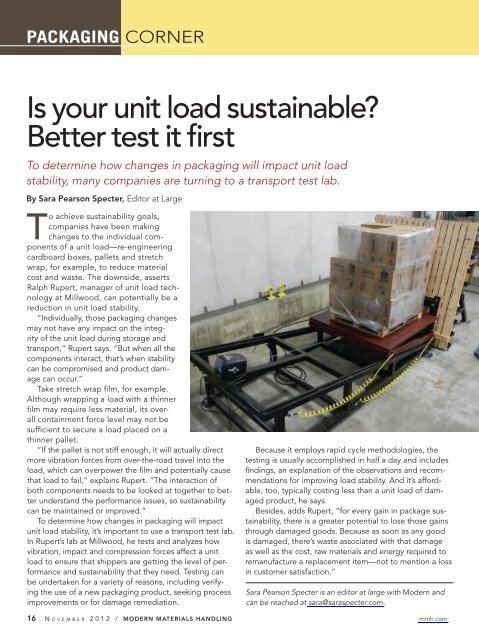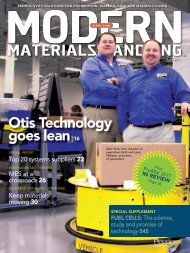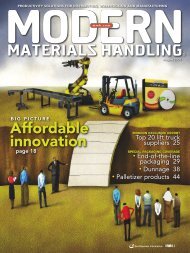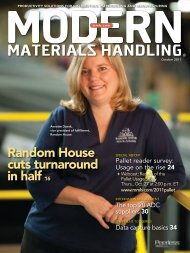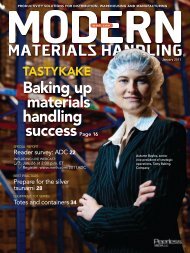Modern Materials Handling - November 2012
Modern Materials Handling - November 2012
Modern Materials Handling - November 2012
Create successful ePaper yourself
Turn your PDF publications into a flip-book with our unique Google optimized e-Paper software.
packaging cornerIs your unit load sustainable?Better test it firstTo determine how changes in packaging will impact unit loadstability, many companies are turning to a transport test lab.By Sara Pearson Specter, Editor at LargeTo achieve sustainability goals,companies have been makingchanges to the individual componentsof a unit load—re-engineeringcardboard boxes, pallets and stretchwrap, for example, to reduce materialcost and waste. The downside, assertsRalph Rupert, manager of unit load technologyat Millwood, can potentially be areduction in unit load stability.“Individually, those packaging changesmay not have any impact on the integrityof the unit load during storage andtransport,” Rupert says. “But when all thecomponents interact, that’s when stabilitycan be compromised and product damagecan occur.”Take stretch wrap film, for example.Although wrapping a load with a thinnerfilm may require less material, its overallcontainment force level may not besufficient to secure a load placed on athinner pallet.“If the pallet is not stiff enough, it will actually directmore vibration forces from over-the-road travel into theload, which can overpower the film and potentially causethat load to fail,” explains Rupert. “The interaction ofboth components needs to be looked at together to betterunderstand the performance issues, so sustainabilitycan be maintained or improved.”To determine how changes in packaging will impactunit load stability, it’s important to use a transport test lab.In Rupert’s lab at Millwood, he tests and analyzes howvibration, impact and compression forces affect a unitload to ensure that shippers are getting the level of performanceand sustainability that they need. Testing canbe undertaken for a variety of reasons, including verifyingthe use of a new packaging product, seeking processimprovements or for damage remediation.Because it employs rapid cycle methodologies, thetesting is usually accomplished in half a day and includesfindings, an explanation of the observations and recommendationsfor improving load stability. And it’s affordable,too, typically costing less than a unit load of damagedproduct, he says.Besides, adds Rupert, “for every gain in package sustainability,there is a greater potential to lose those gainsthrough damaged goods. Because as soon as any goodis damaged, there’s waste associated with that damageas well as the cost, raw materials and energy required toremanufacture a replacement item—not to mention a lossin customer satisfaction.”Sara Pearson Specter is an editor at large with <strong>Modern</strong> andcan be reached at sara@saraspecter.com.16 N o v e m b e r 2 0 1 2 / <strong>Modern</strong> <strong>Materials</strong> <strong>Handling</strong> mmh.com


